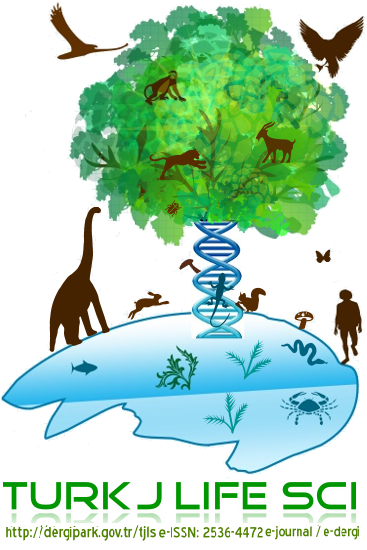Paralepistopsis amoenolens: Nadir ve Zehirli Bir Taksonun Türkiye'deki İlk Kaydı
Bu çalışmada, nadir ve zehirli bir tür olan Paralepistopsis amoenolens (Kokulu felceden) Türkiye’den ilk kez rapor edilmektedir. Türün fotoğrafı ile birlikte mikroskobik görüntüsü ve deskripsiyonu verilmektedir.
Anahtar Kelimeler:
Zehirli tür, eritromelalji, taksonomi, Tricholomataceae
Paralepistopsis amoenolens: First Record of A Rare and Poisonous Taxon in Turkey
In this study, the rare and poisonous species Paralepistopsis amoenolens (Turkish: Kokulu felceden, English: Paralysis funnel) is reported from Turkey for the first time. Microscopic images and descriptions of the species are given together with macroscopic photographs.
Keywords:
Toxic species, erythromelalgia, taxonomy, Tricholomataceae,
___
- Akata I, Kaya A, Uzun Y. 2016. Two new genus records for Turkish Helotiales. Kastamonu Univ. Journal of Forestry Faculty, 16/1: 131–134.
- Bresinsky A, Besl H. 1990. A Colour Atlas of Poisonous Fungi: A handbook for pharmacists, doctors, and biologists. Wolfe Publishing Ltd., 295 p.
- Contu M, Signorello P, Anastase A. 1999. Clitocybe amoenolens Mal. in Abruzzo con osservazioni sulla sua posizione sistematica. Boll. Ass. Micol. Ecol. Romana, 48/3: 16–18.
- Çolak ÖF, Kaygusuz O, Işıloğlu M. 2017. Two Lactarius species mycorrhizal with Cistus laurifolius in Turkey. Current Research in Environmental & Applied Mycology, 7/1: 26–32.
- Çolak ÖF, Şen İ, Işıloğlu M. 2015. Lactifluus rugatus (Kühner & Romagn.) Verbeken, a new record for Turkish Mycota. BioDiCon, 8/2: 114–116.
- Doğan HH, Kurt F. 2016. New macrofungi records from Turkey and macrofungal diversity of Pozantı-Adana. Turk J Bot, 40/2: 209–217.
- Evans S, Kibby G. 2004. Pocket Nature: Fungi. Dorling Kindersley, 296p.
- Ichimura T. 1918. A new poisonous mushroom. Bot Gaz, 65: 109–111.
- Intini M, Doğan HH, Riva A. 2003. Tricholoma anatolicum spec. nov.: A new member of the Matsutake group. Micol Veget Medit, 18/2: 135–142.
- Işık H, Türkekul İ. 2017. A new record for Turkish mycota from Akdağmadeni (Yozgat) province: Russula decolorans (Fr.) Fr. Epicr. Ant J Bot, 1/1: 1–3.
- Işıloğlu M, Allı H, Solak MH, Watling R. 2009. A new Marasmius on Castanea sativa from Turkey. Mycotaxon, 107: 343–347.
- Işıloğlu M, Allı H, Spooner BM, Solak MH. 2010. Morchella anatolica (Ascomycota), a new species from southwestern Anatolia, Turkey. Mycologia 102/2: 455–458.
- Kaygusuz O, Çolak ÖF. 2017a. New records of Helotiales in Turkey. ScienceAsia, 43/4: 217–222.
- Kaygusuz O, Çolak ÖF. 2017b. Typhula spathulata – first record from Turkey. Czech Mycology, 69/2: 125–131.
- Kaygusuz O, Gezer K, Şeker M. 2016. Four new records of Pluteus Fr. from interesting habitats in the Aegean region of Turkey. Botany Letters, 163/3: 251–259.
- Leonardi M, Ciulli G, Pacioni G, Recchia G. 2002. Una intossicazione collettiva da Clitocybe amoenolens riconducibile alla sindrome acromelalgica. Micol Veget Medit, 17/2: 133–142.
- Martínez F, Martínez R, Meléndez A, Pérez Del Amo CM. 2010. Clitocybe amoenolens Primera cita para España. Bol Soc Micol Madrid, 34: 103–112.
- Menemen Y, Aytaç Z, Kandemir A. 2016. Türkçe Bilimsel Bitki Adları Yönergesi. Bağbahçe Bilim Dergisi, 3/3:1–3.
- Moreau PA, Courtecuisse R, Guez D, Garcin R, Neville P, Saviuc P, Seigle-Murandi F. 2001. Analyse taxinomique d’une espèce toxique: Clitocybe amoenolens Malençon. Cryptogam Mycol, 22/2: 95–117.
- Nakajima N, Ueda M, Higashi N, Katayama Y. 2013. Erythromelalgia associated with Clitocybe acromelalga intoxication. Clin Toxicol, 51: 451–454.
- Nakamura K, Shoyama F, Toyama J, Tateishi K. 1987. Empoisonnement par le Dokou-sassa-ko (Clitocybe acromelalga). Jpn J Toxicol, 1: 35–39.
- Saviuc P, Danel V. 2006. New syndromes in mushroom poisoning. Toxicol Rev, 25/3: 199–209.
- Saviuc PF, Danel VC, Moreau PA, Guez DR, Claustre AM, Carpentier PH, Mallaret MP, Ducluzeau R. 2001. Erythromelalgia and mushroom poisoning. Clin Toxicol, 39/4: 403–407.
- Sesli E, Denchev CM. 2008. Checklists of the myxomycetes, larger ascomycetes, and larger basidiomycetes in Turkey. Mycotaxon, 106: 65–67. + [complete version, 1–145, new version uploaded in January 2014].
- Sesli E, Topcu-Sesli A. 2017. Infundibulicybe alkaliviolascens (Tricholomataceae): Türkiye Mikotası için Yeni Bir Kayıt. Mantar Dergisi, 8/1:6–12.
- Sesli E, Vizzini A, Contu M. 2015. Lyophyllum turcicum (Agaricomycetes: Lyophyllaceae), a new species from Turkey. Turk J Bot, 39/3: 512–519.
- Sesli E, Vizzini A, Ercole E, Contu M. 2016. Clitolyophyllum akcaabatense gen. nov., sp. nov. (Agaricales, Tricholomataceae); a new fan-shaped clitocyboid agaric from Turkey. Botany, 94/2: 73–80.
- Solak MH, Işıloğlu M, Kalmış E, Allı H. 2015. Macrofungi of Turkey, Checklist, Volume 2. Üniversiteliler Ofset, İzmir. Şen İ, Allı H, Civelek HS. 2016. Checklist of Turkish Truffles. Turk J Life Sci, 1/2:103–109.
- Topcu-Sesli A, Sesli E. 2016. Psilocybe semilanceata (Fries) Kumber (Strophariaceae): Türkiye için yeni bir halüsinojen mantar. Bağbahçe Bilim Dergisi, 3/1: 34–40.
- Türkekul İ. 2017. New Calbovista, Mycena, Rhizopogon, Stictis, and Symphyosirinia records from Turkey. Mycotaxon, 132/3: 503–512.
- Uzun Y, Kaya A, Karacan İH, Yakar S. 2017. New additions to Turkish Agaricales. BioDiCon, 10/2: 8–13.
- Vizzini A, Antonin V, Sesli E, Contu M. 2015. Gymnopus trabzonensis sp. nov. (Omphalotaceae) and Tricholoma virgatum var. fulvoumbonatum var. nov. (Tricholomataceae), two new white-spored agarics from Turkey. Phytotaxa, 226/2: 119–130.
- Vizzini A, Ercole E. 2012. Paralepistopsis gen. nov. and Paralepista (Basidiomycota, Agaricales). Mycotaxon, 120/1: 253–267.
- Watling R, Işıloglu M, Baş Sermenli H. 2010. Observations on the Bolbitiaceae 31. Conocybe volviradicata sp. nov. Mycotaxon, 114: 145–149.
- Başlangıç: 2016
- Yayıncı: Ömer Faruk ÇOLAK
Sayıdaki Diğer Makaleler
Betül TİN, Cemal KURTOĞLU, Emre SEVİNDİK
Paralepistopsis amoenolens: Nadir ve Zehirli Bir Taksonun Türkiye'deki İlk Kaydı
Ömer F. ÇOLAK, Oğuzhan KAYGUSUZ, Eliseo BATTISTIN
Biyosensörler: Gıda ve Sağlık Alanında Laktat Biyosensörleri
Özüm ÖZOĞLU, Mehmet Altay ÜNAL, Evrim GÜNEŞ ALTUNTAŞ
Bülent TOPRAK, Oktay YILDIZ, Murat SARGINCI, Şükrü Teoman GÜNER, Aysun PEKŞEN, Ernaz ALTUNDAĞ ÇAKIR
